
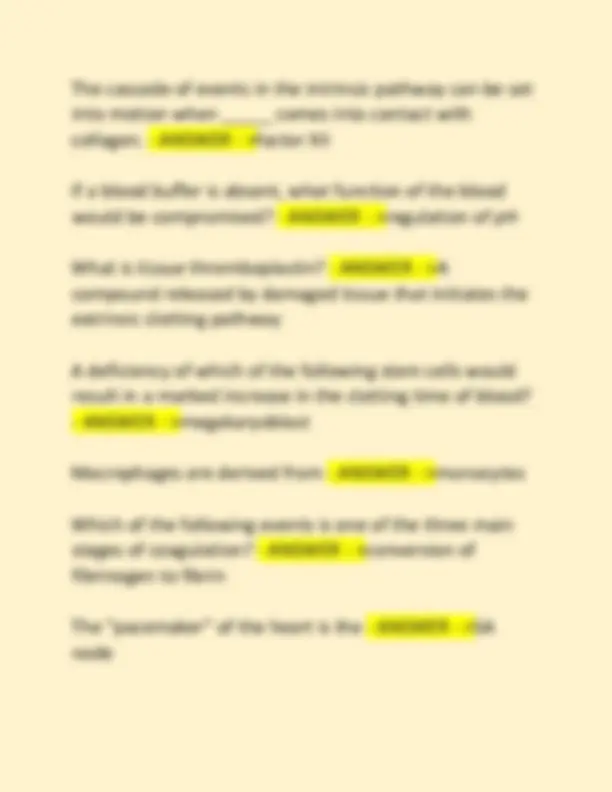
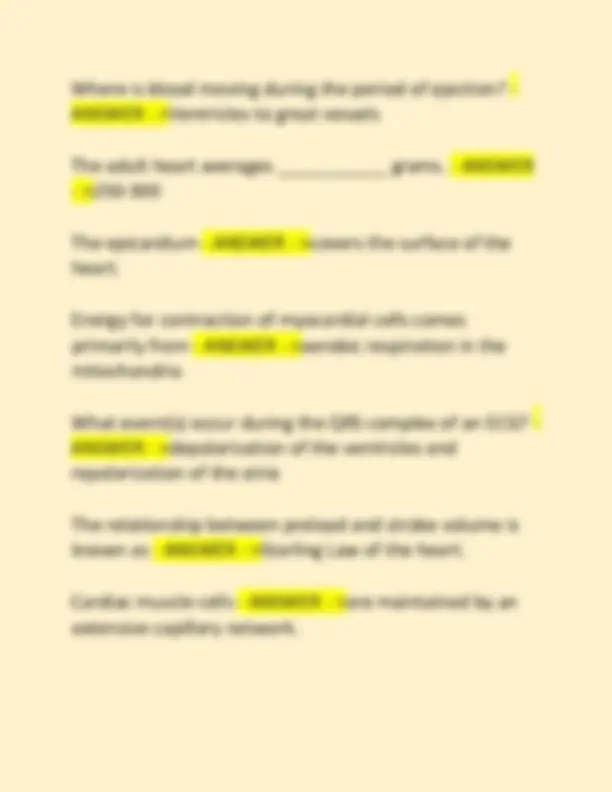
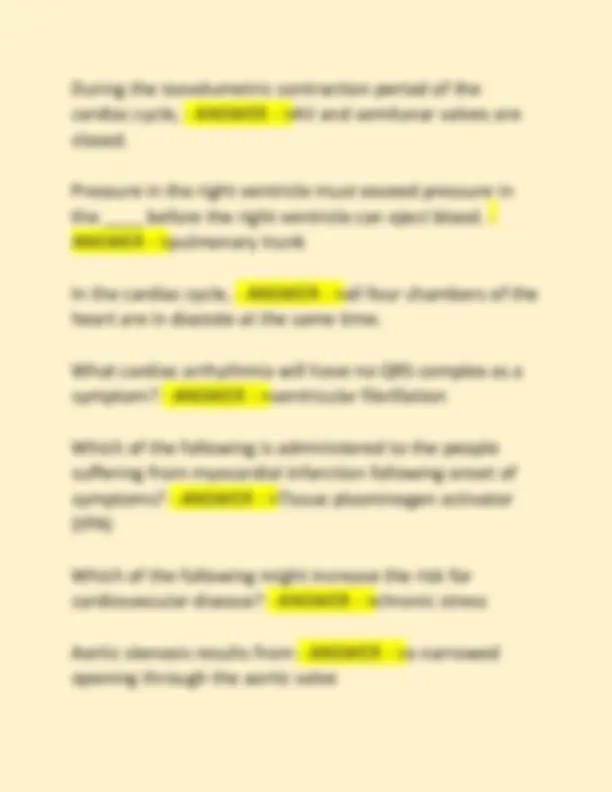
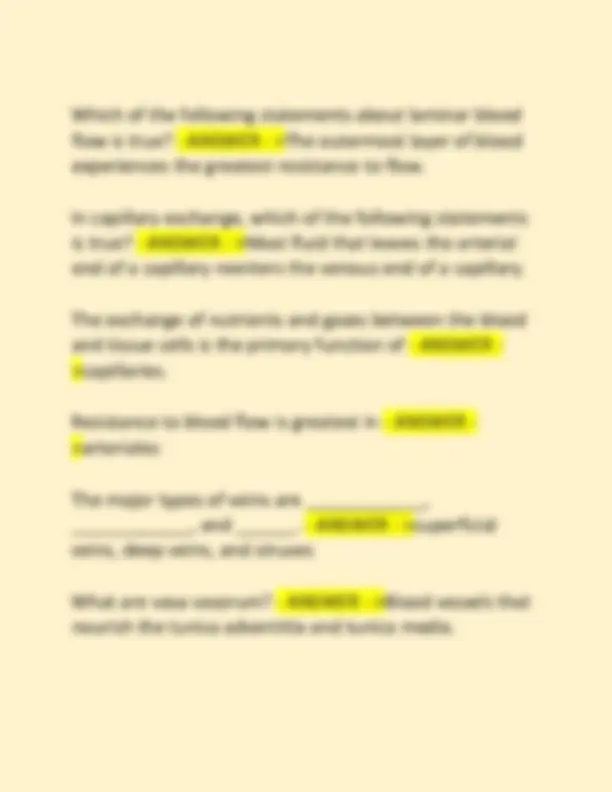
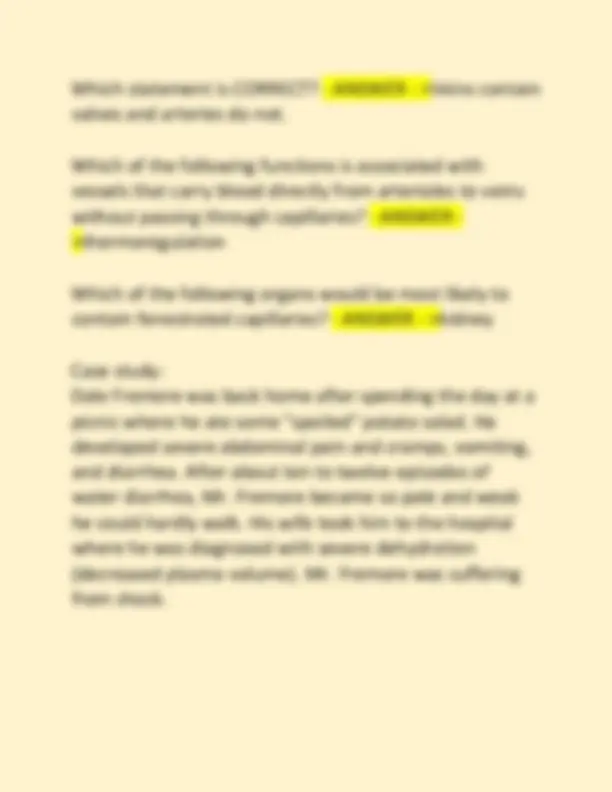
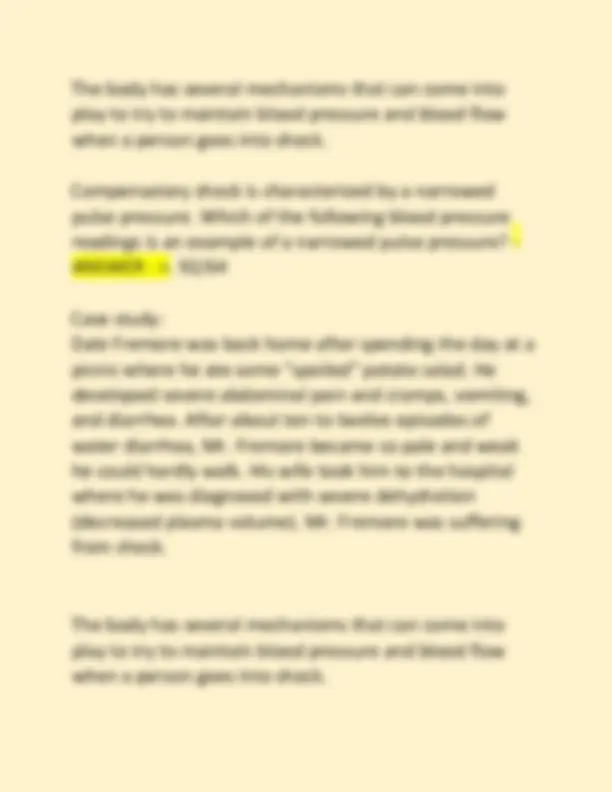
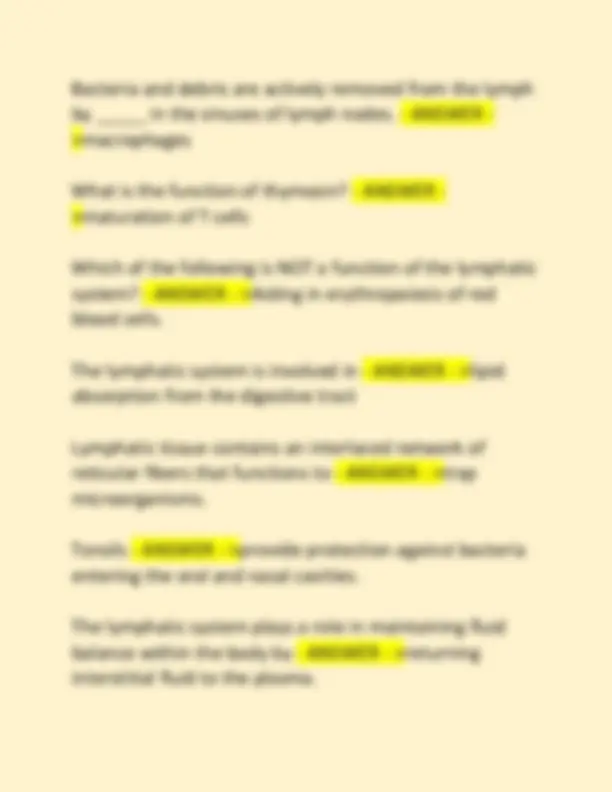
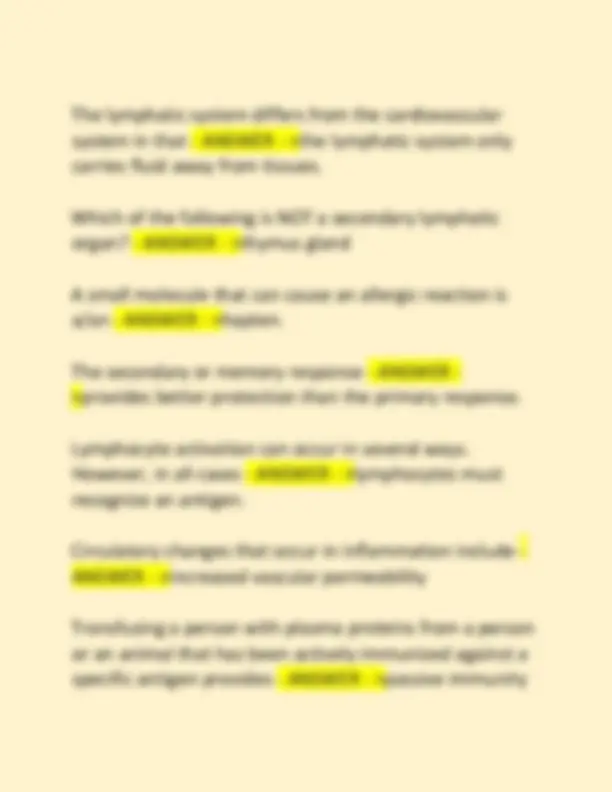
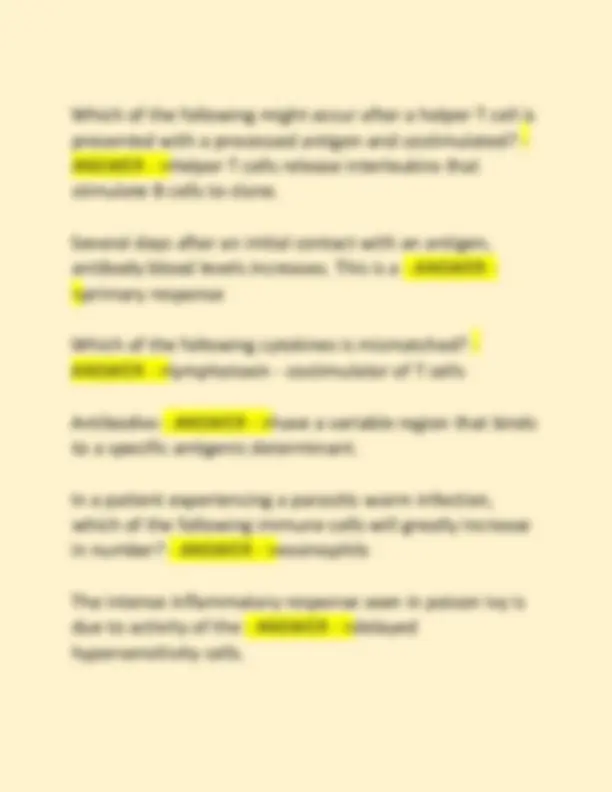
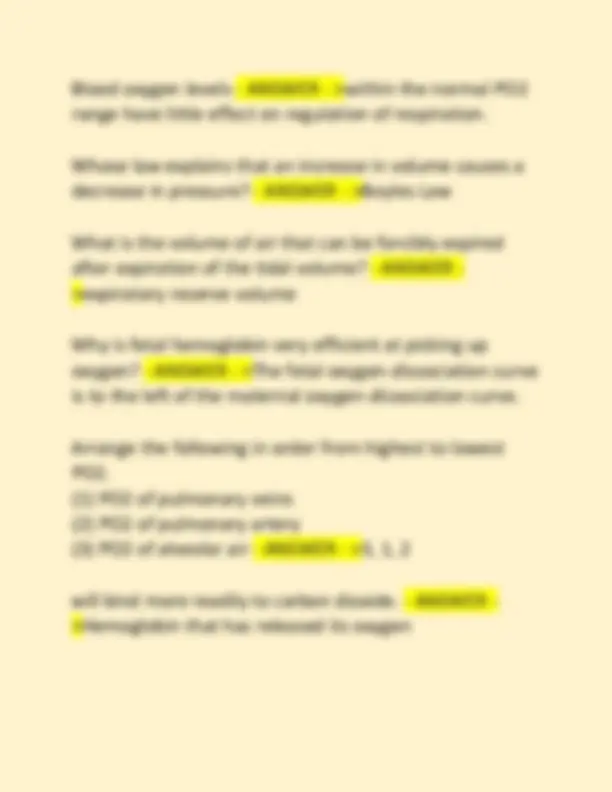
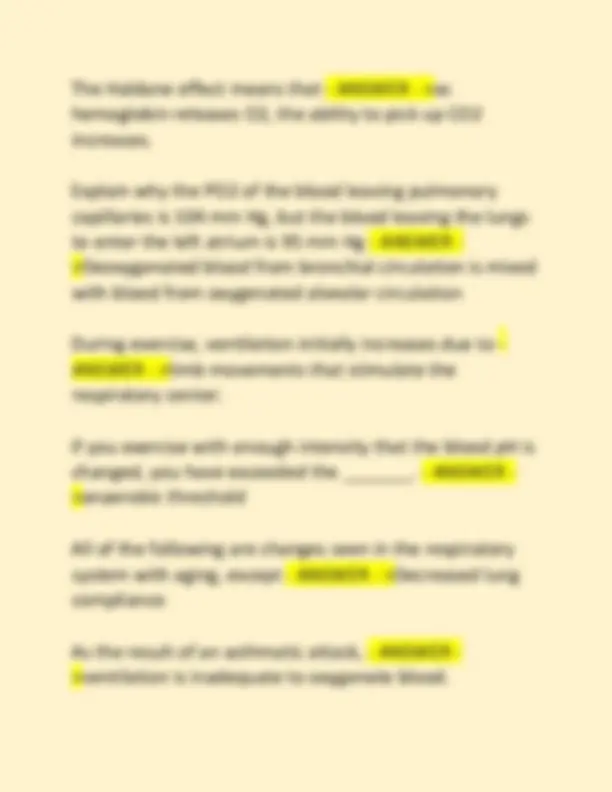
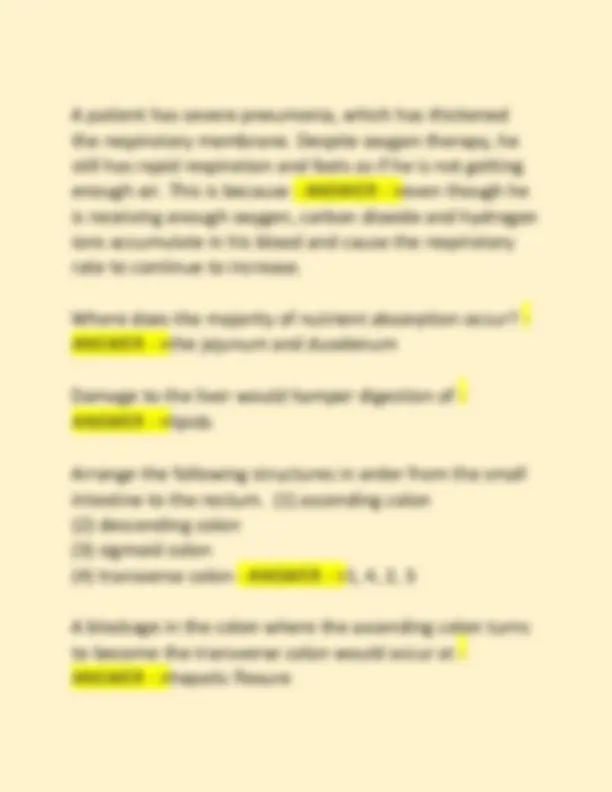
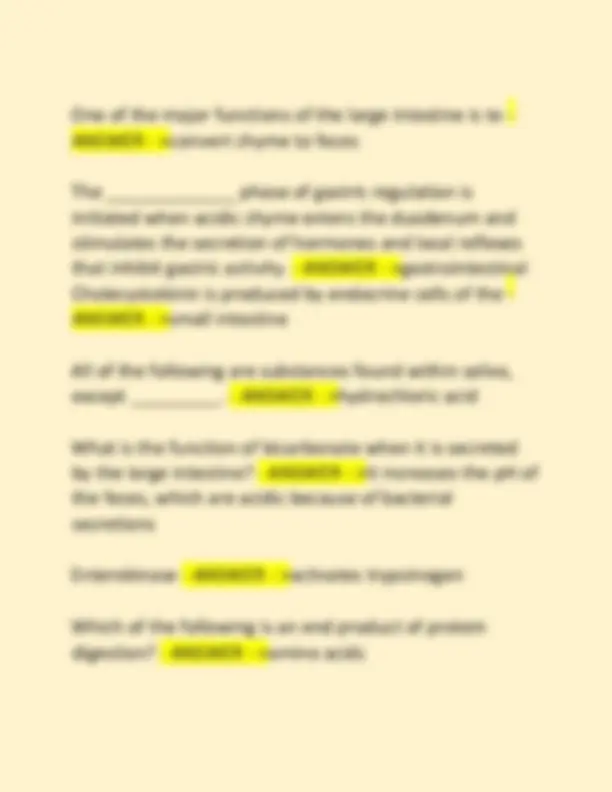
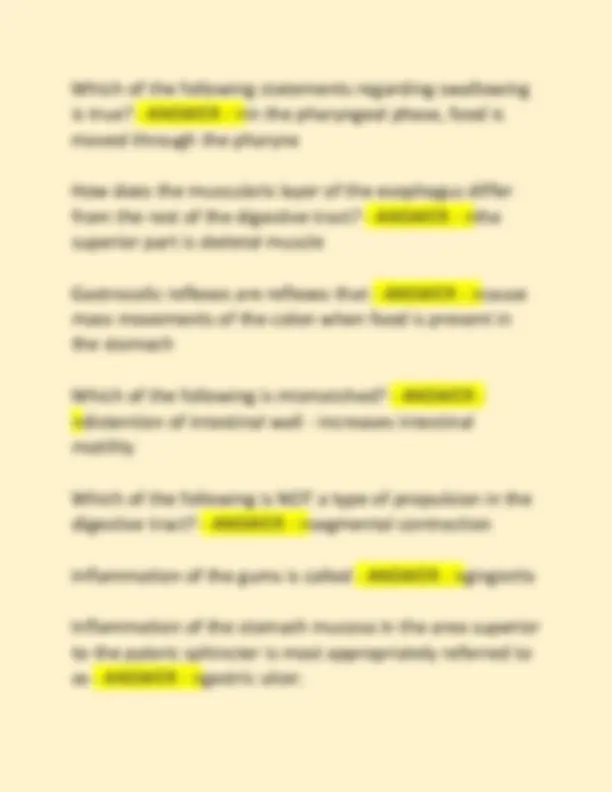
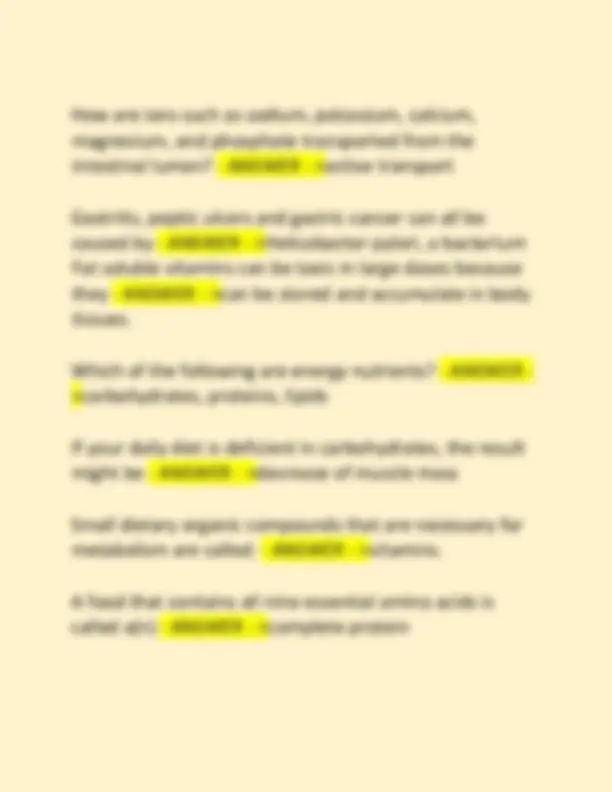
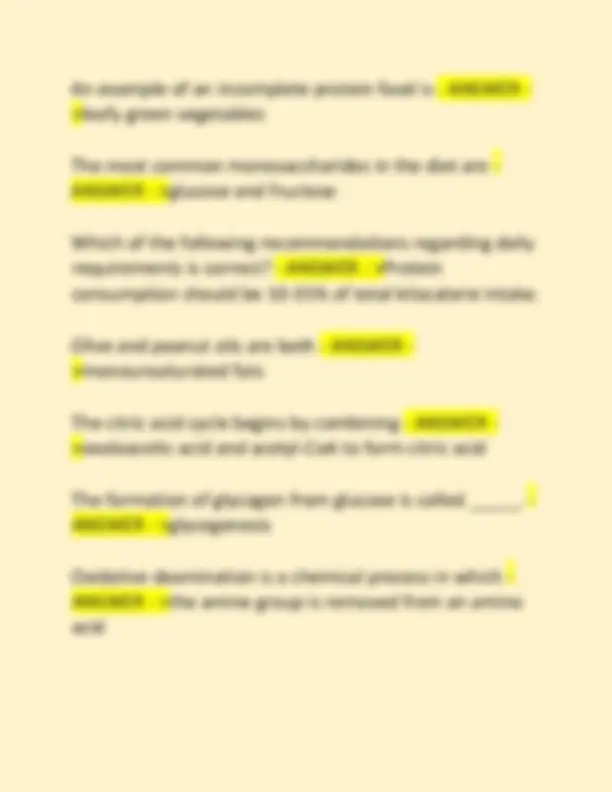
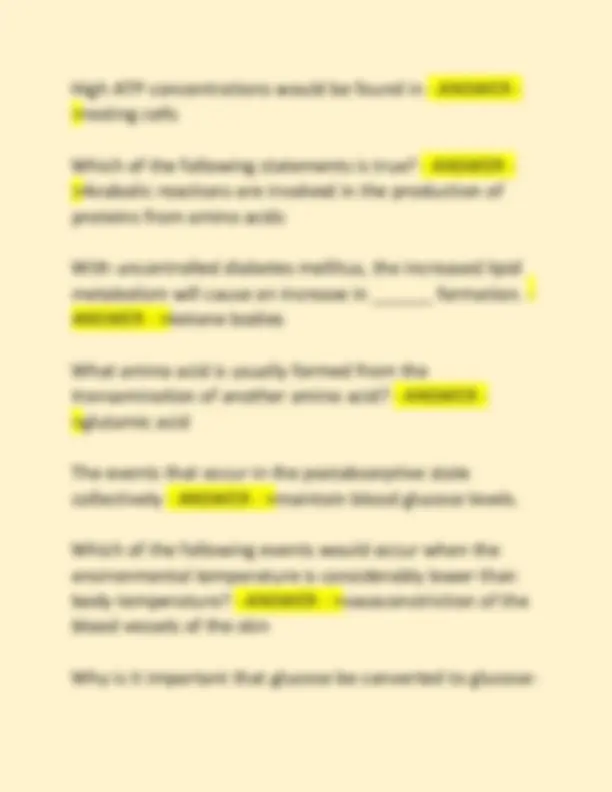
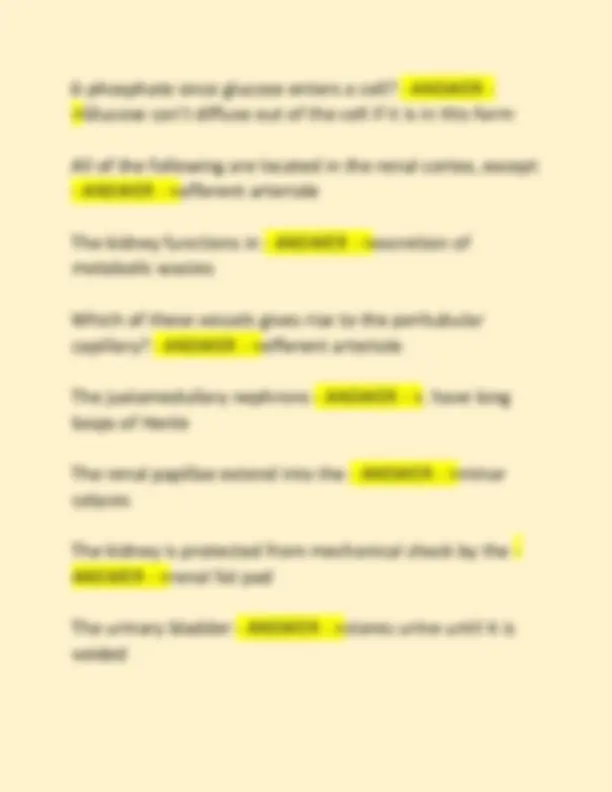
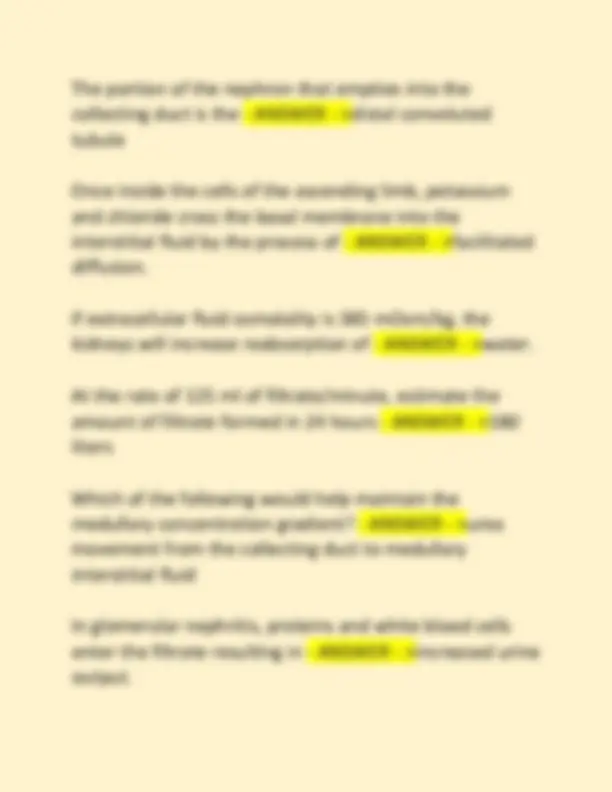
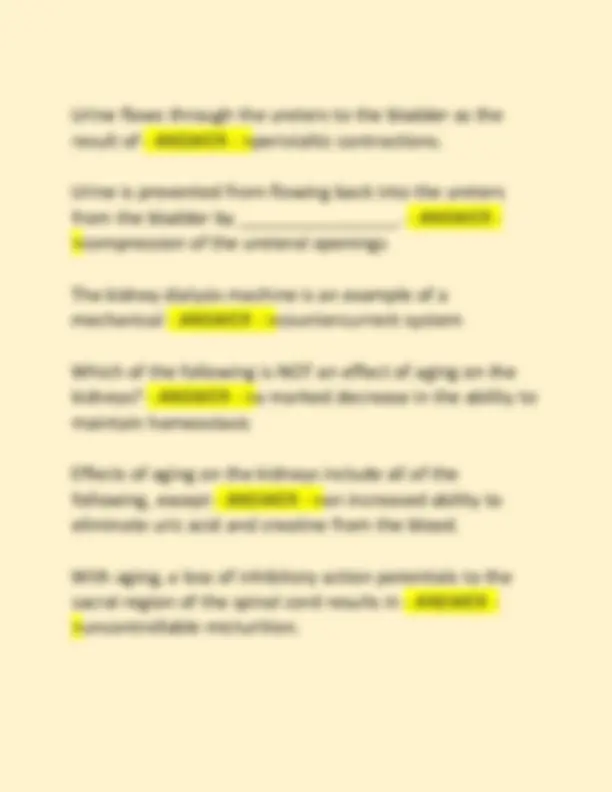
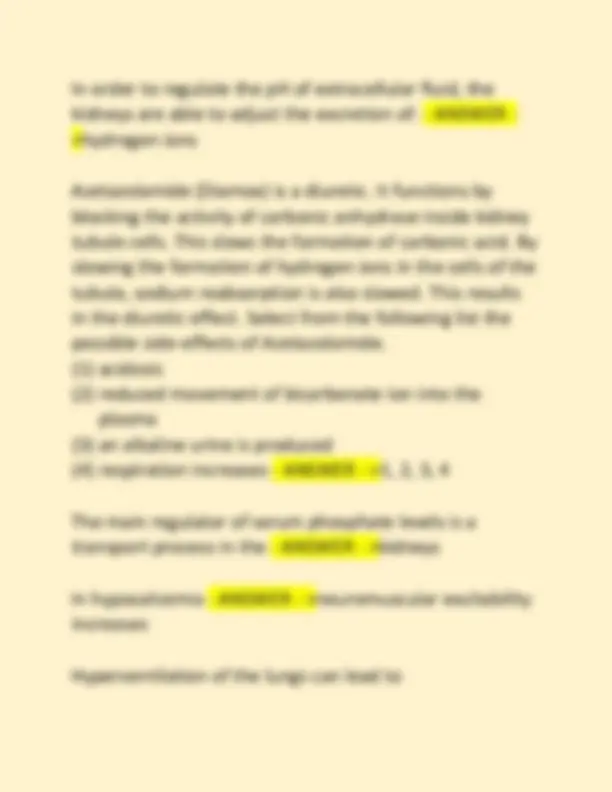
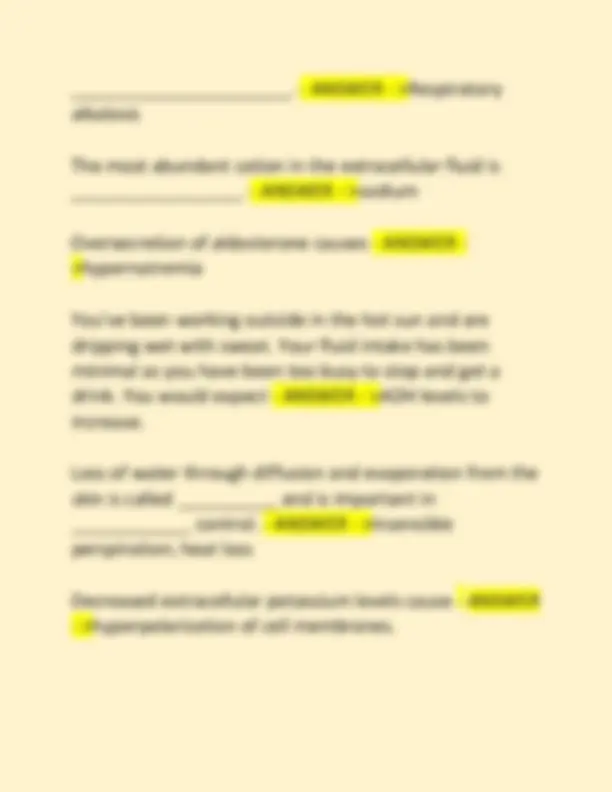
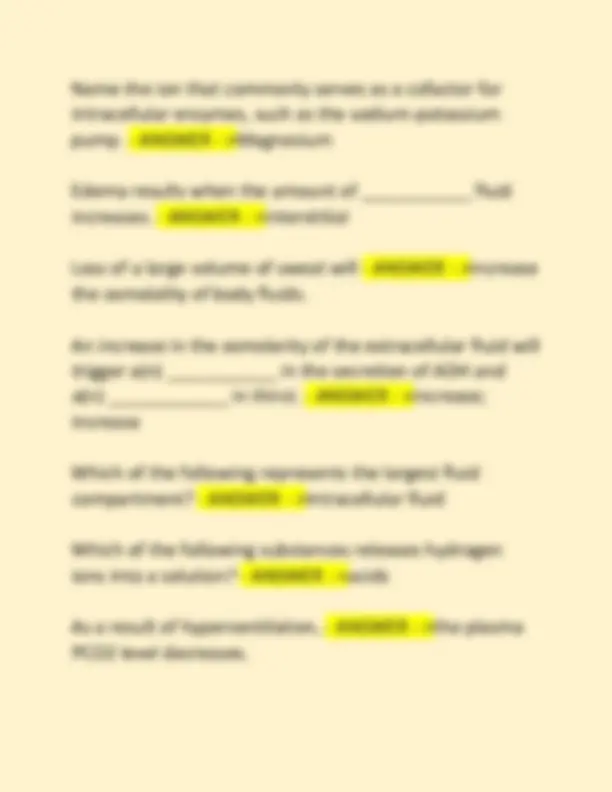
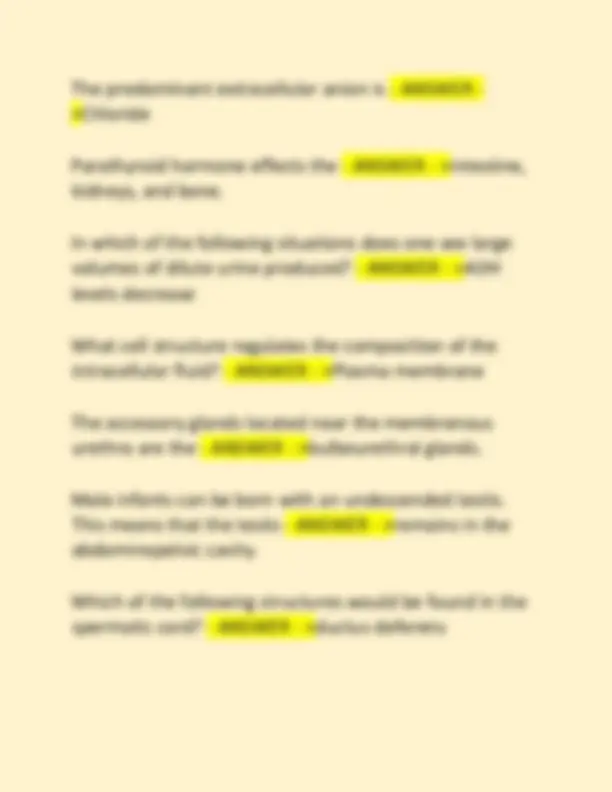
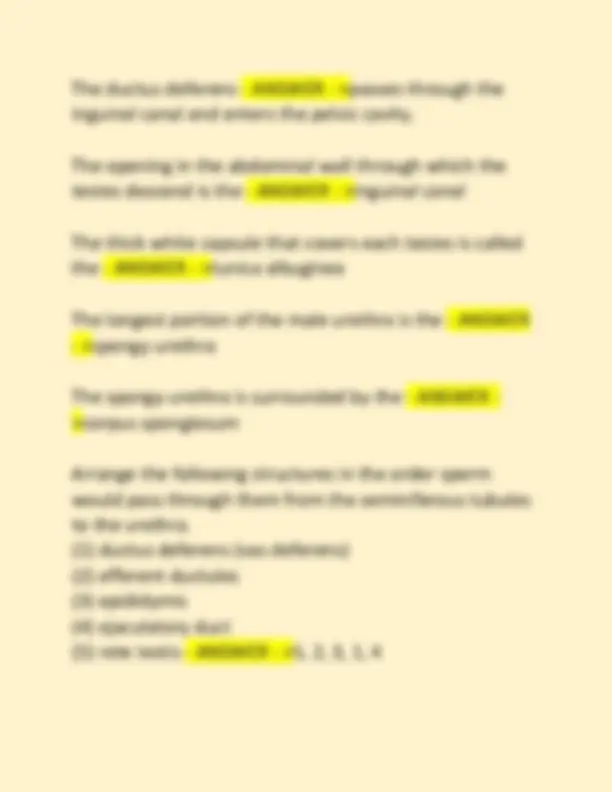
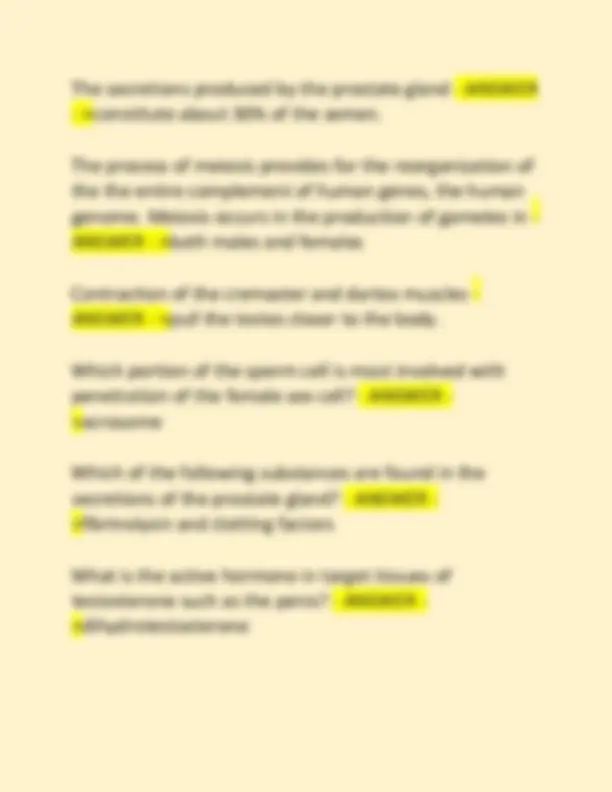
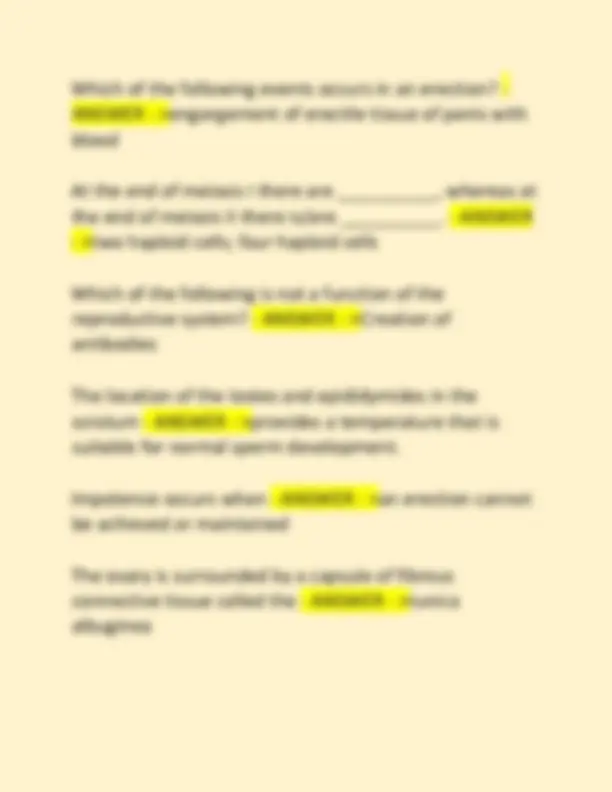
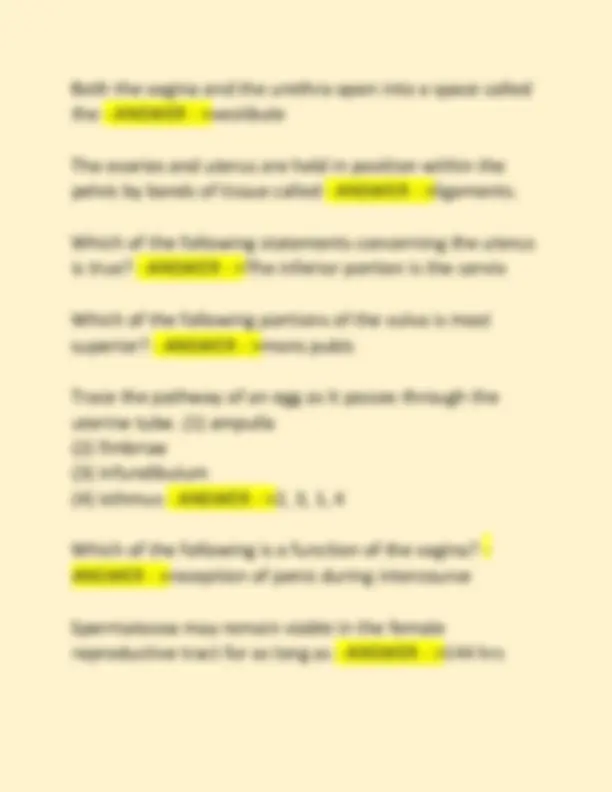
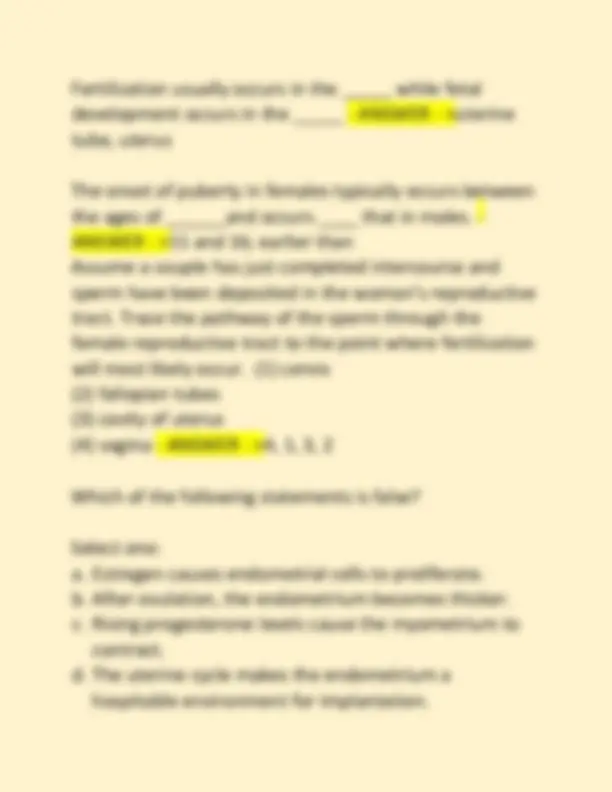
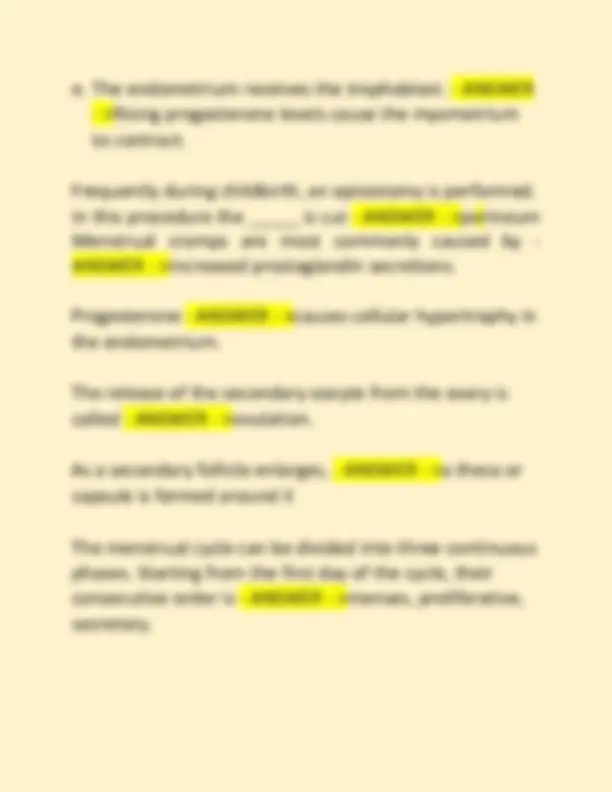
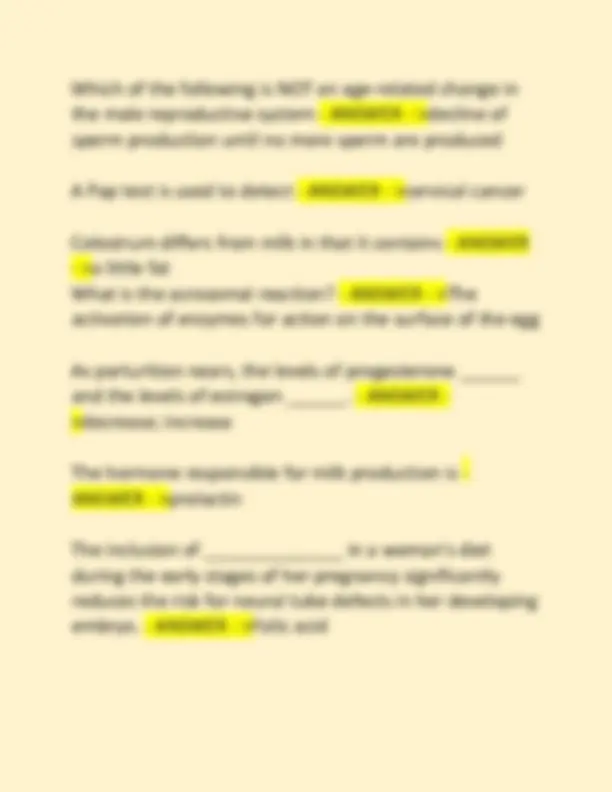
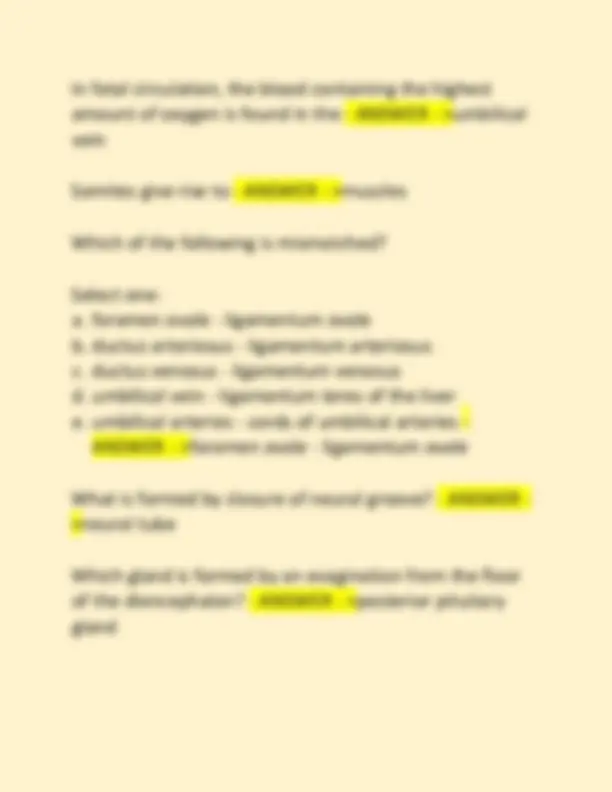
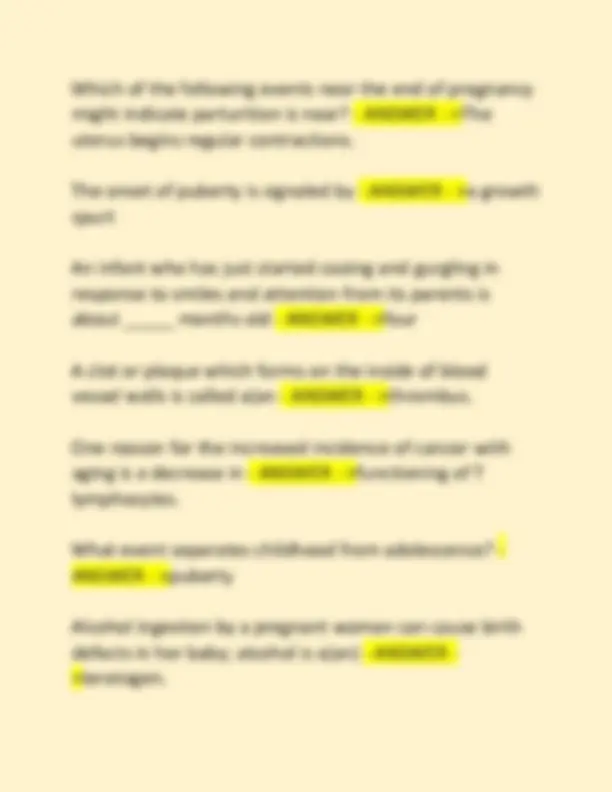
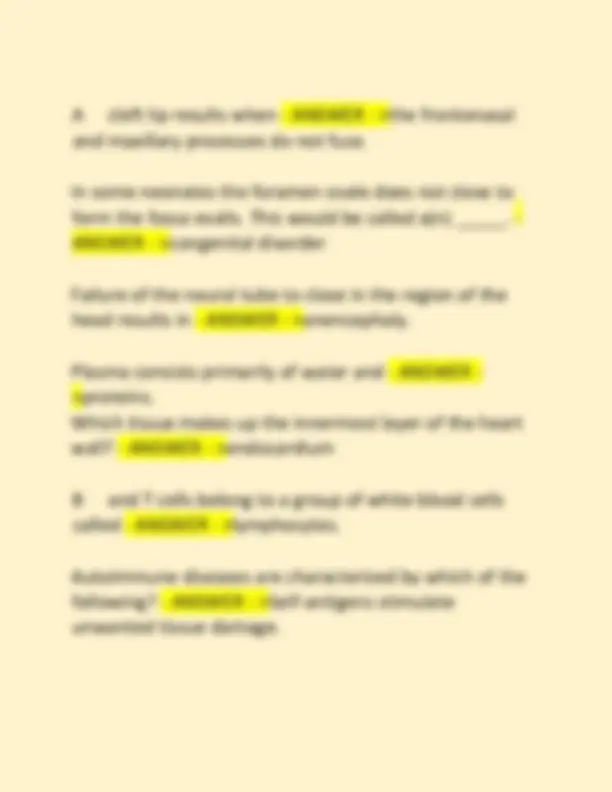
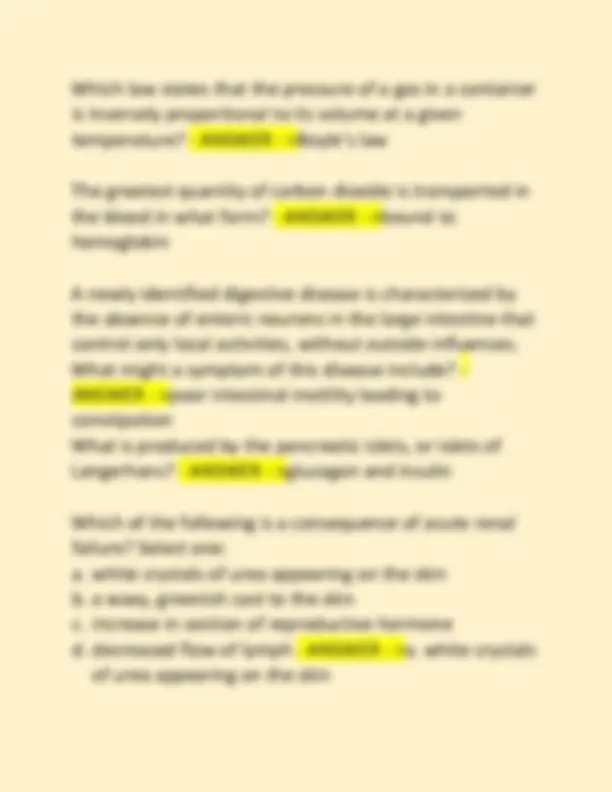
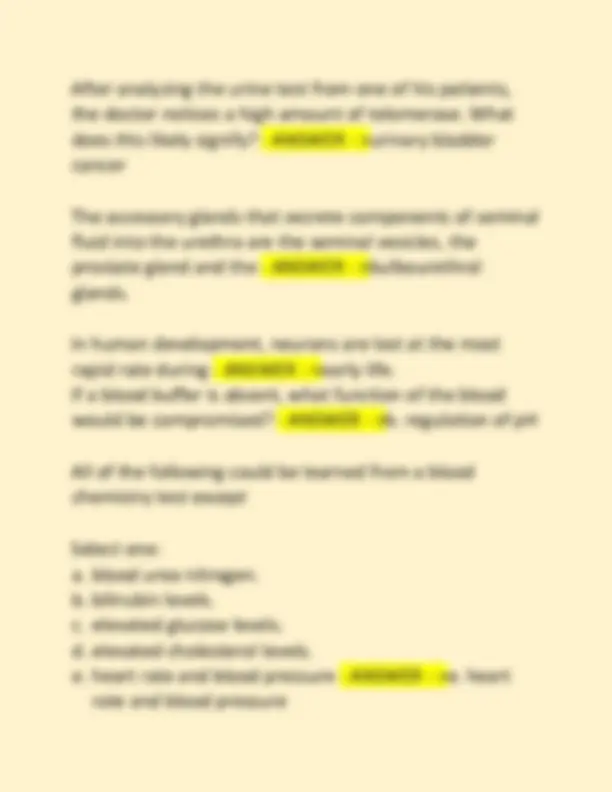
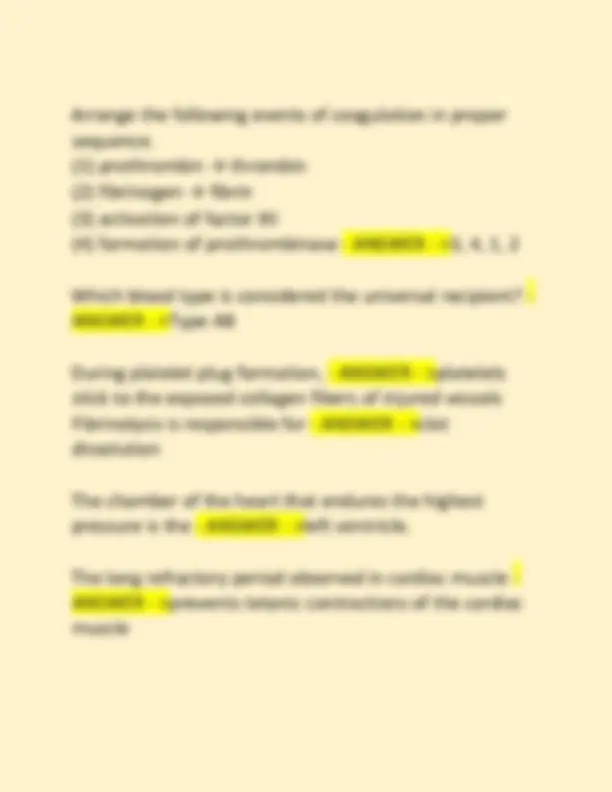
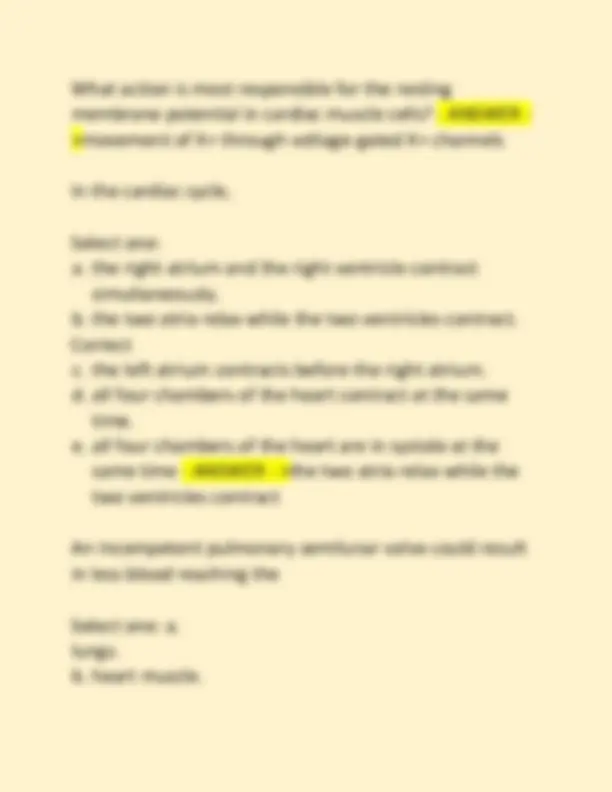
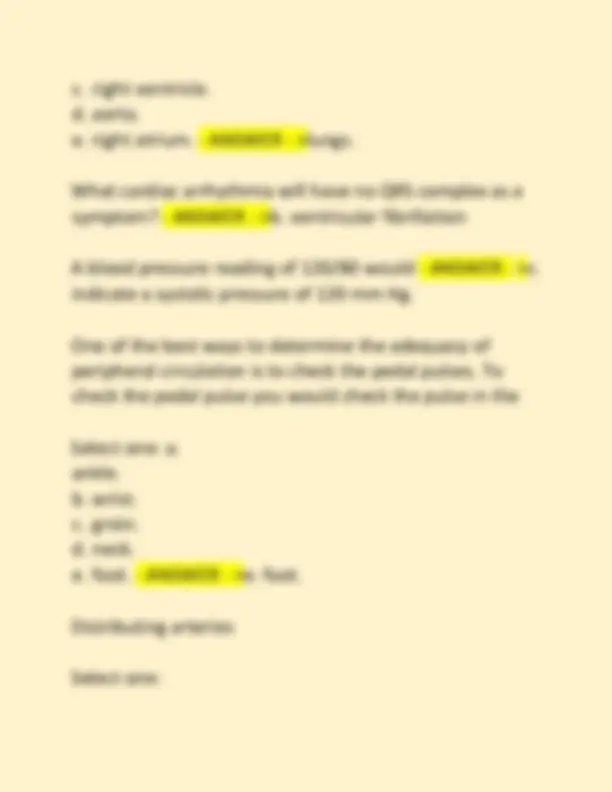
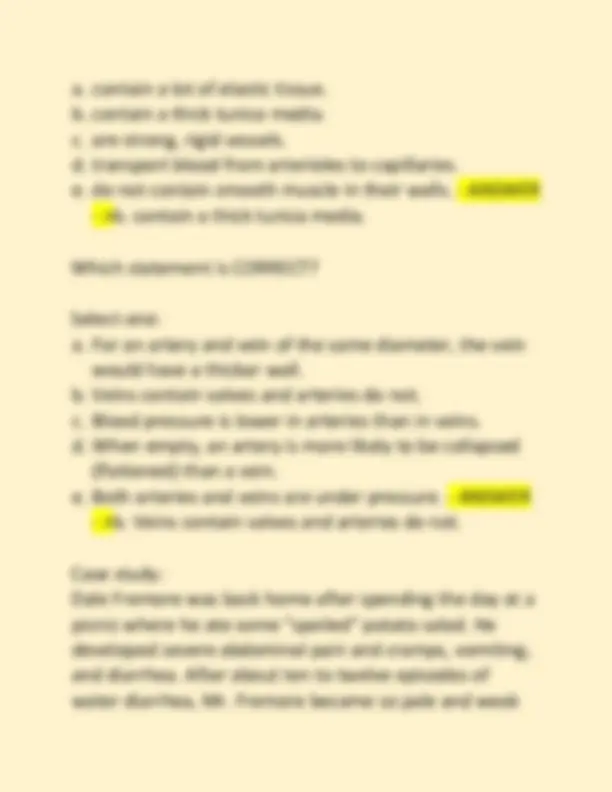
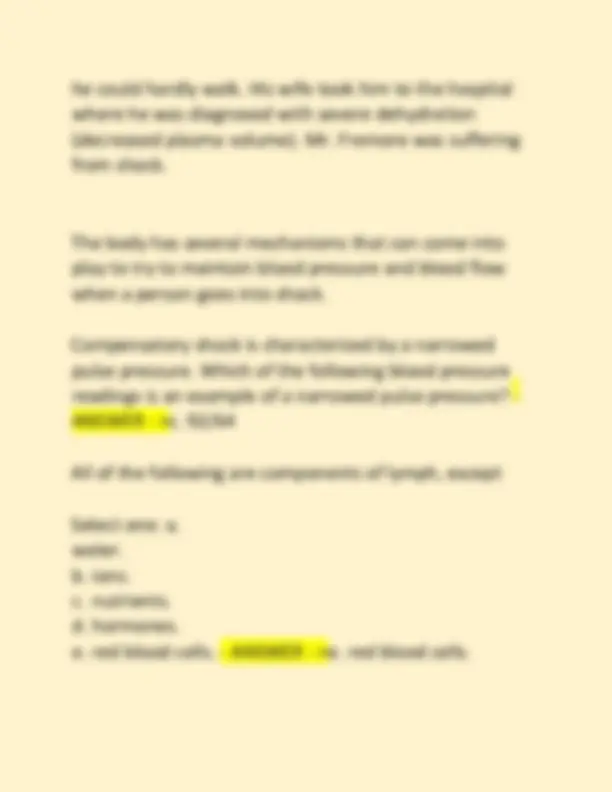
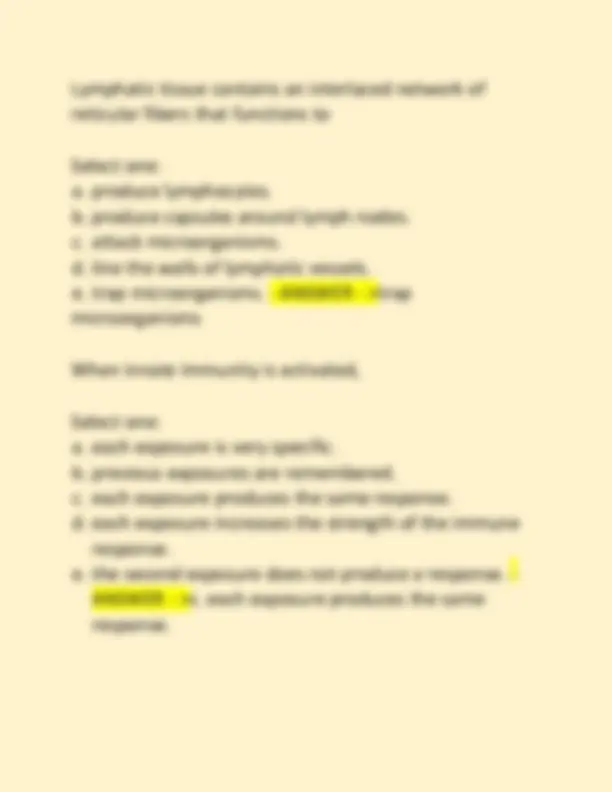
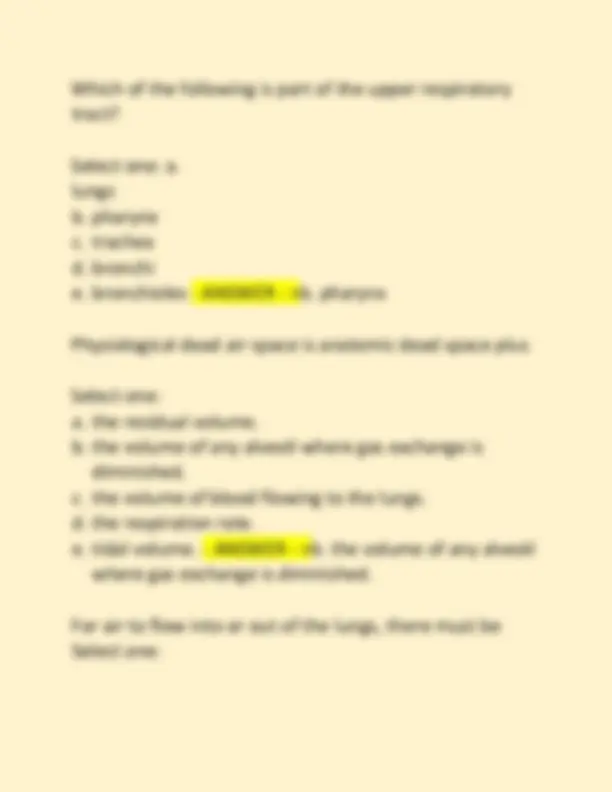
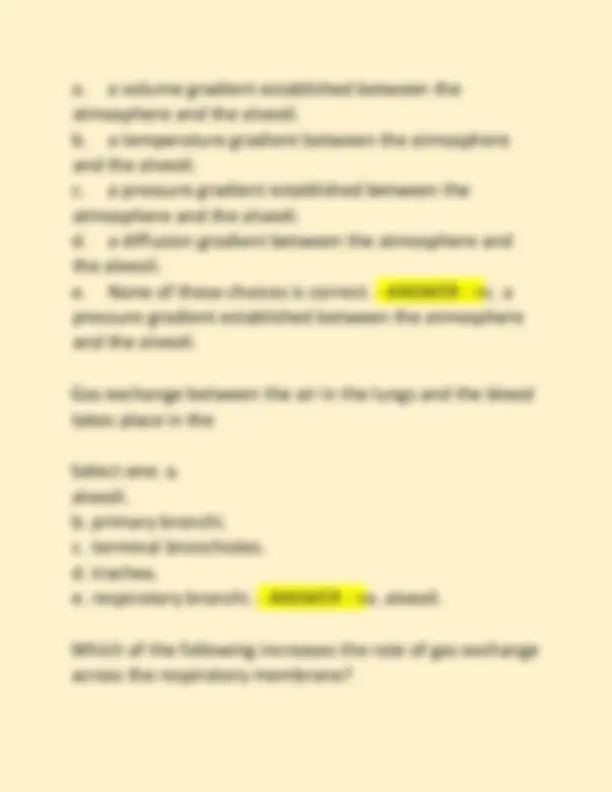
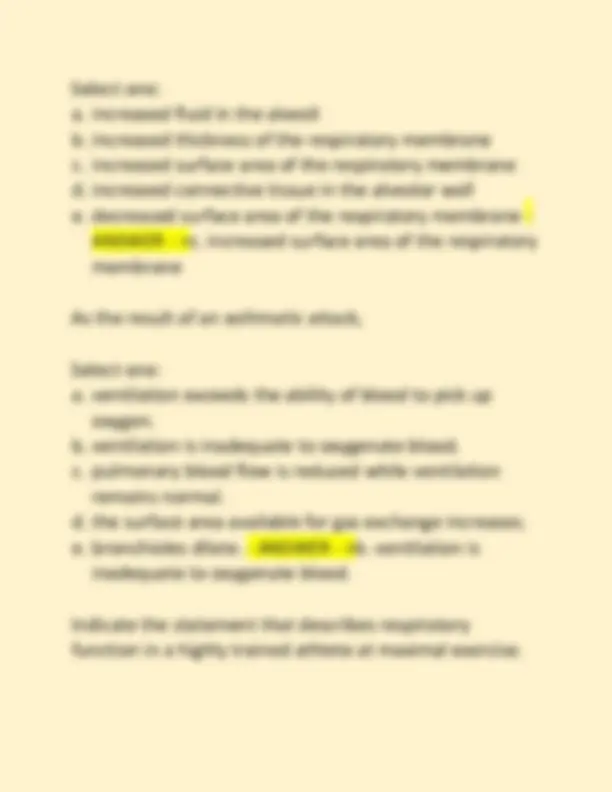
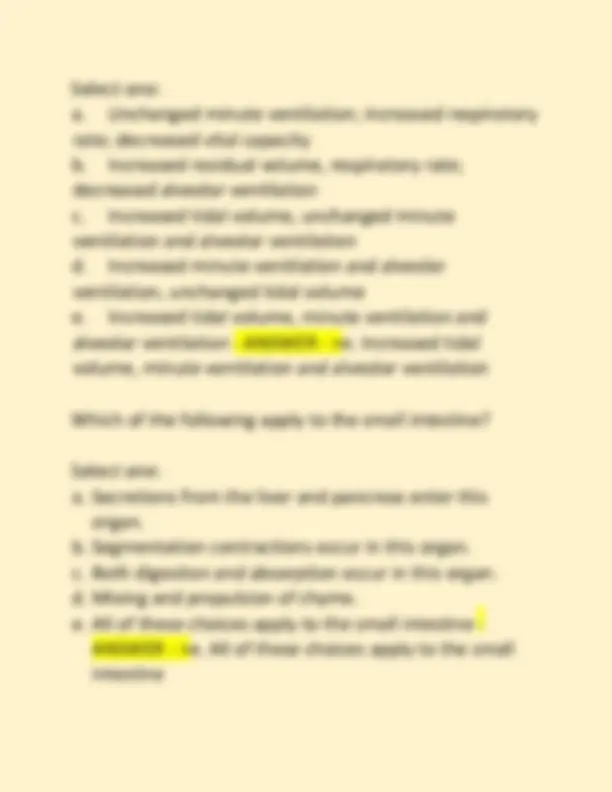
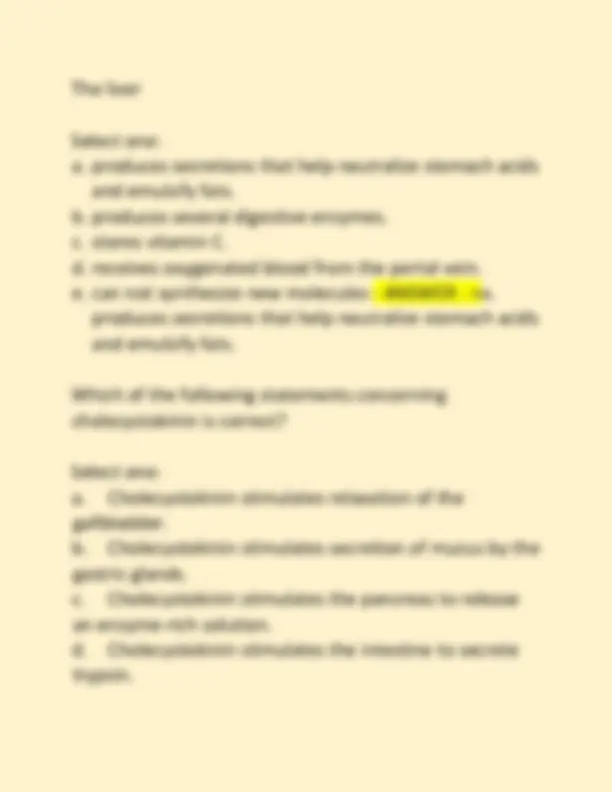
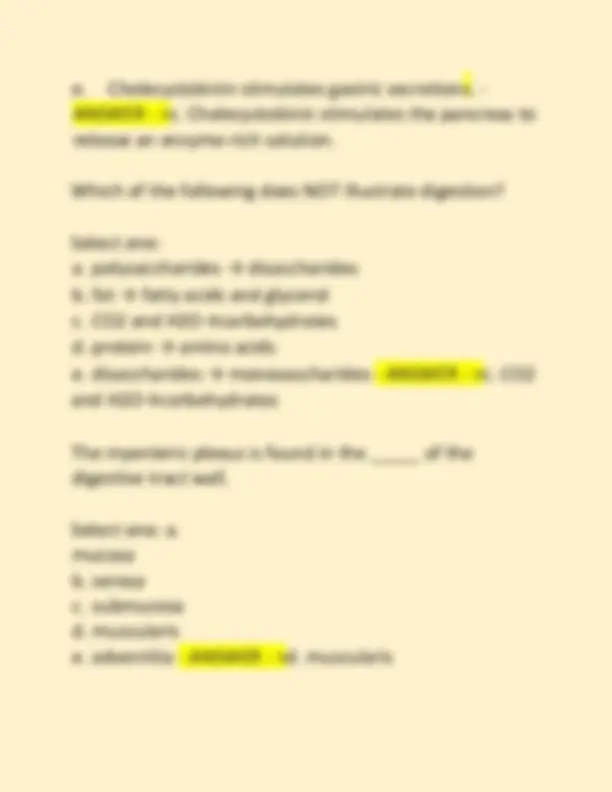
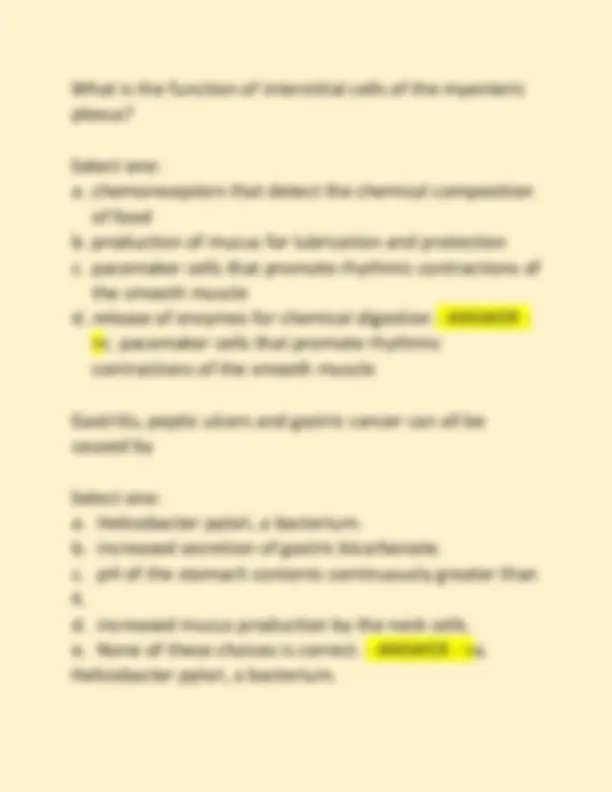


Study with the several resources on Docsity

Earn points by helping other students or get them with a premium plan


Prepare for your exams
Study with the several resources on Docsity

Earn points to download
Earn points by helping other students or get them with a premium plan
Community
Ask the community for help and clear up your study doubts
Discover the best universities in your country according to Docsity users
Free resources
Download our free guides on studying techniques, anxiety management strategies, and thesis advice from Docsity tutors
A series of questions and answers related to anatomy and physiology, specifically focusing on the circulatory and lymphatic systems. It covers topics such as blood composition, blood types, clotting mechanisms, heart function, blood pressure regulation, and lymphatic system components. The questions are designed to test understanding of key concepts and processes within these systems, making it a useful resource for students studying a&p. It also includes case studies to apply knowledge to real-world scenarios, enhancing comprehension and critical thinking skills. A valuable tool for exam preparation and review.
Typology: Exams
1 / 57

This page cannot be seen from the preview
Don't miss anything!


















































A&P 2 STRAIGHTERLINE FINAL EXAM QUESTIONS WITH COMPLETE SOLUTIONS GUARANTEED PASS A GRADED When erythrocytes are destroyed, which of the following events occurs? - ANSWER - >The globin portion of the molecule is broken down into amino acids. Type AB blood - ANSWER - >has both A and B antigens on the red cells In the platelet release reaction, - ANSWER - >ADP and thromboxanes stimulate other platelets to become activated. The hematocrit is - ANSWER - >d. the percentage of RBCs in a given volume of blood. What vitamin is necessary to produce many clotting factors in the liver? - ANSWER - >Vitamin K A white blood cell engulfing a bacterium is an example of blood functioning in - ANSWER - >a. protection.
The oxygenated form of hemoglobin is called - ANSWER -
oxyhemoglobin The only formed elements that possess a nucleus when mature are the - ANSWER - >c. leukocytes Plasma - ANSWER - >. is the liquid matrix of the blood. An increased amount of heparin in the blood might - ANSWER - >. prevent clotting process. On which chromosome is there a mutation that leads to sickle cell anemia? - ANSWER - >b. chromosome 11 Blood consists of a matrix of plasma and cells; blood is a subtype of ______ tissue. - ANSWER - >e. connective The ability of white blood cells to leave the circulation and enter tissues is called - ANSWER - >b. diapedesis. The nervous system and certain chemicals can cause the constriction of a blood vessel. This is known as - ANSWER
b. vascular spasm
Where is blood moving during the period of ejection? - ANSWER - >Ventricles to great vessels The adult heart averages ___________ grams. - ANSWER
250 - 300 The epicardium - ANSWER - >covers the surface of the heart. Energy for contraction of myocardial cells comes primarily from - ANSWER - >aerobic respiration in the mitochondria What event(s) occur during the QRS complex of an ECG? - ANSWER - >depolarization of the ventricles and
repolarization of the atria The relationship between preload and stroke volume is known as - ANSWER - >Starling Law of the heart. Cardiac muscle cells - ANSWER - >are maintained by an extensive capillary network.
During the isovolumetric contraction period of the cardiac cycle, - ANSWER - >AV and semilunar valves are closed. Pressure in the right ventricle must exceed pressure in the ____ before the right ventricle can eject blood. - ANSWER - >pulmonary trunk In the cardiac cycle, - ANSWER - >all four chambers of the heart are in diastole at the same time. What cardiac arrhythmia will have no QRS complex as a symptom? - ANSWER - >ventricular fibrillation Which of the following is administered to the people suffering from myocardial infarction following onset of symptoms? - ANSWER - >Tissue plasminogen activator (tPA) Which of the following might increase the risk for cardiovascular disease? - ANSWER - >chronic stress Aortic stenosis results from - ANSWER - >a narrowed opening through the aortic valve
Which of the following thoracic organs is supplied by a parietal branch of the thoracic aorta? - ANSWER - >the intercostal muscles Increased pressure in the aortic arch will activate the aortic arch reflex and cause - ANSWER - >increased parasympathetic stimulation of the heart. According to Poiseuille's law, - ANSWER - >if resistance increases, flow decreases The vein that ascends along the medial side of the lower limb to the femoral vein is the ____ saphenous vein and the vein that ascends along the posterior aspect of the leg to the popliteal vein is the _____ saphenous vein. - ANSWER - >great; small If someone has a blood pressure reading of 110/70 mm Hg, their pulse pressure would be - ANSWER - >40 mm Hg. What is the most important means by which capillary exchange occurs? - ANSWER - >diffusion
Which of the following statements about laminar blood flow is true? - ANSWER - >The outermost layer of blood experiences the greatest resistance to flow. In capillary exchange, which of the following statements is true? - ANSWER - >Most fluid that leaves the arterial end of a capillary reenters the venous end of a capillary. The exchange of nutrients and gases between the blood and tissue cells is the primary function of - ANSWER -
capillaries. Resistance to blood flow is greatest in - ANSWER - arterioles The major types of veins are ____________, ____________, and ______. - ANSWER - >superficial veins, deep veins, and sinuses What are vasa vasorum? - ANSWER - >Blood vessels that nourish the tunica adventitia and tunica media.
The body has several mechanisms that can come into play to try to maintain blood pressure and blood flow when a person goes into shock. Compensatory shock is characterized by a narrowed pulse pressure. Which of the following blood pressure readings is an example of a narrowed pulse pressure? - ANSWER - >. 92/ Case study: Dale Fremore was back home after spending the day at a picnic where he ate some "spoiled" potato salad. He developed severe abdominal pain and cramps, vomiting, and diarrhea. After about ten to twelve episodes of water diarrhea, Mr. Fremore became so pale and weak he could hardly walk. His wife took him to the hospital where he was diagnosed with severe dehydration (decreased plasma volume). Mr. Fremore was suffering from shock. The body has several mechanisms that can come into play to try to maintain blood pressure and blood flow when a person goes into shock.
Urine output usually decreases when a person is in shock. This is the result of - ANSWER - >increased renin secretion. In response to circulatory shock, - ANSWER - >the reninangiotensin mechanism is activated. In which of the following would you detect a weak pulse?
Thin-walled, with overlapping squamous cells
Bacteria and debris are actively removed from the lymph by _____ in the sinuses of lymph nodes. - ANSWER -
macrophages What is the function of thymosin? - ANSWER - maturation of T cells Which of the following is NOT a function of the lymphatic system? - ANSWER - >Aiding in erythropoiesis of red blood cells. The lymphatic system is involved in - ANSWER - >lipid absorption from the digestive tract Lymphatic tissue contains an interlaced network of reticular fibers that functions to - ANSWER - >trap microorganisms. Tonsils - ANSWER - >provide protection against bacteria entering the oral and nasal cavities. The lymphatic system plays a role in maintaining fluid balance within the body by - ANSWER - >returning interstitial fluid to the plasma.
The lymphatic system differs from the cardiovascular system in that - ANSWER - >the lymphatic system only carries fluid away from tissues. Which of the following is NOT a secondary lymphatic organ? - ANSWER - >thymus gland A small molecule that can cause an allergic reaction is a/an - ANSWER - >hapten. The secondary or memory response - ANSWER -
provides better protection than the primary response. Lymphocyte activation can occur in several ways. However, in all cases - ANSWER - >lymphocytes must recognize an antigen. Circulatory changes that occur in inflammation include - ANSWER - >increased vascular permeability Transfusing a person with plasma proteins from a person or an animal that has been actively immunized against a
specific antigen provides - ANSWER - >passive immunity
Which of the following is NOT an aging effect of the lymphatic system and immunity? - ANSWER - >Fluid removal by the lymphatic capillaries is reduced. The HIV virus infects - ANSWER - >helper T cells. An abnormal, exaggerated response of the immune system is called - ANSWER - >hypersensitivity Which of the following is false? - ANSWER - >There is currently only one cure for AIDS - AZT. Several research groups are working on vaccines that will be effective against the AIDS virus. When a successful vaccine is produced, it is likely to be injected to produce - ANSWER - >active artificial immunity. In immunodeficiency diseases, - ANSWER - >inadequate B and/or T cell formation may occur. The largest of the laryngeal cartilages is the - ANSWER -
thyroid cartilage
What is the function of the nasal conchae? - ANSWER -
increases turbulence and surface area for cleaning, warming and moisturizing the air During swallowing, the opening into the larynx is covered by the - ANSWER - >epiglottis Arrange the following structures in the order air passes through them during inhalation: (1) alveolar ducts (2) alveolus (3) respiratory bronchiole (4) terminal bronchiole - ANSWER - >4, 3, 1, 2 Which of the following is NOT a process of respiration? - ANSWER - >voice production The major regulator of respiration is the plasma concentration of - ANSWER - >carbon dioxide Rhythmicity of breathing involves - ANSWER - >the preBötzinger complex of the ventral respiratory group.
The Haldane effect means that - ANSWER - >as hemoglobin releases O2, the ability to pick up CO increases. Explain why the PO2 of the blood leaving pulmonary capillaries is 104 mm Hg, but the blood leaving the lungs to enter the left atrium is 95 mm Hg - ANSWER -
Deoxygenated blood from bronchial circulation is mixed with blood from oxygenated alveolar circulation During exercise, ventilation initially increases due to - ANSWER - >limb movements that stimulate the respiratory center. If you exercise with enough intensity that the blood pH is changed, you have exceeded the _______. - ANSWER - anaerobic threshold All of the following are changes seen in the respiratory system with aging, except - ANSWER - >Decreased lung compliance As the result of an asthmatic attack, - ANSWER - ventilation is inadequate to oxygenate blood.
A patient has severe pneumonia, which has thickened the respiratory membrane. Despite oxygen therapy, he still has rapid respiration and feels as if he is not getting enough air. This is because - ANSWER - >even though he is receiving enough oxygen, carbon dioxide and hydrogen ions accumulate in his blood and cause the respiratory rate to continue to increase. Where does the majority of nutrient absorption occur? - ANSWER - >the jejunum and duodenum Damage to the liver would hamper digestion of - ANSWER - >lipids Arrange the following structures in order from the small intestine to the rectum. (1) ascending colon (2) descending colon (3) sigmoid colon (4) transverse colon - ANSWER - >1, 4, 2, 3 A blockage in the colon where the ascending colon turns to become the transverse colon would occur at - ANSWER - >hepatic flexure